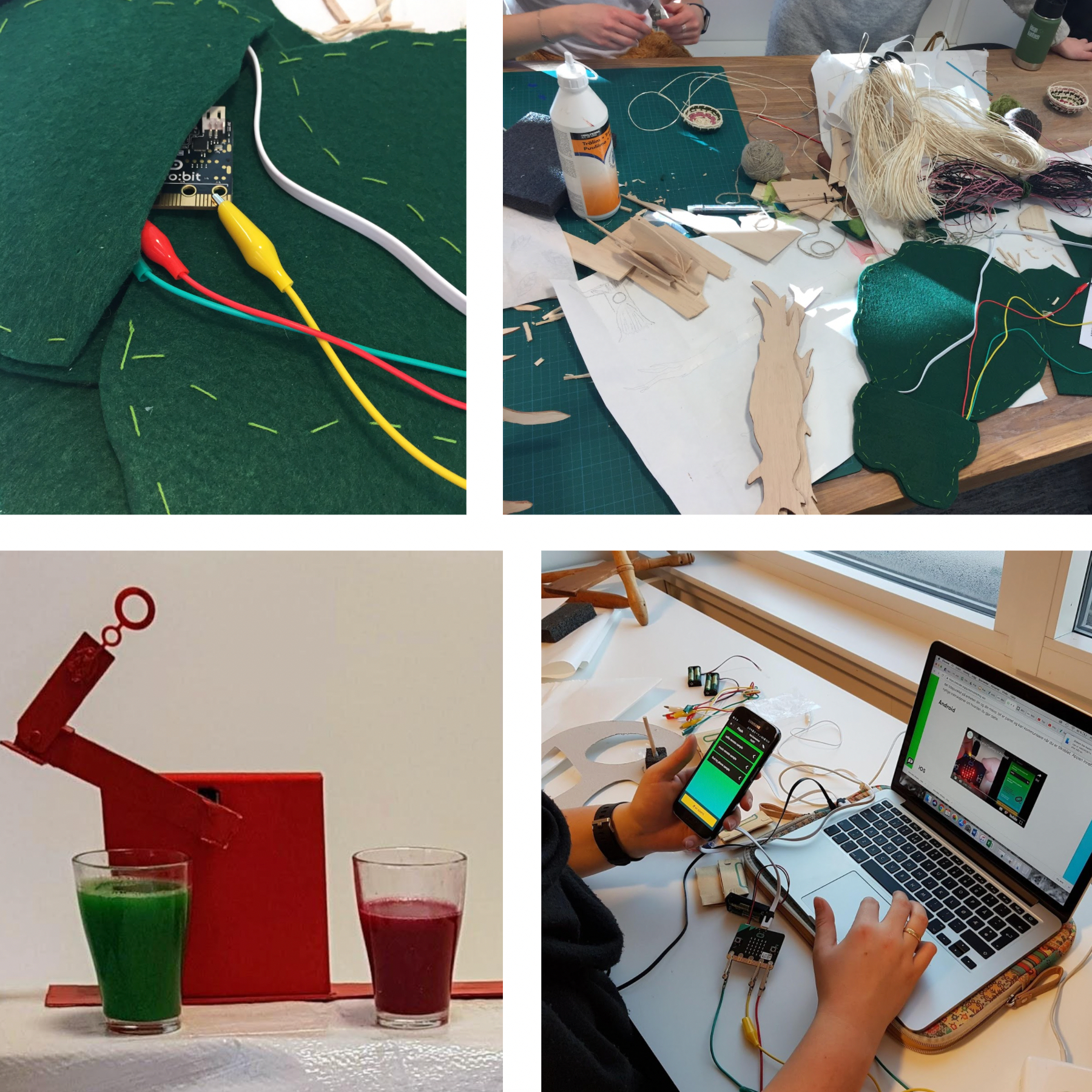Learning about materiality through tinkering with Micro:bits
DOI:
https://doi.org/10.7577/formakademisk.4636Keywords:
Art and design education, materiality, programming, Micro:bits, citizenshipAbstract
This paper discusses two pilot projects in Art and design education at the teacher training at Western Norway University of Applied Sciences. In the second round of drafts for the new curriculum of Art and design digital knowledge is described as stretching from using simple digital resources to master and shape your own digital products. It is no longer limited to two-dimensional visual modelling as previously drafted. This is in our view a new approach in a subject where making, tinkering and designing allows for explorations in both 2D and 3D. Given that we want to encourage the use of the digital together with the use of physical materials, the pilot case studies demonstrate the importance of bringing coding and the material aspects of tinkering, making, and creating into play. The BBC Micro:bit was used to make coding and mechanical control part of projects made with traditional material. Further research and development should be undertaken to bring such practices into classrooms in primary and lower secondary schools.
References
Digranes, I., & Fauske, L. B. (2010). The Reflective Citizen – General Design Education for a Sustainable Future. In C. Boks, C. McMahon, W. Ion, & B. Parkinson (Eds.), When Design Education and Design Research Meet. The 12th International Conference on Engineering and Product Design Education (pp. 364-369). The Design Society. https://hdl.handle.net/10642/539
European Commission. (2015). Science Education for Responsible Citizenship. http://ec.europa.eu/research/swafs/pdf/pub_science_education/KI-NA-26-893-EN-N.pdf
European Design Leadership Board. (2012). Growth and Prosperity (Report and Recommendations of the European Design Leadership Board). http://europeandesigninnovation.eu/wp-content/uploads/2012/09/Design_for_Growth_and_Prosperity_.pdf
Hoem, J. & Schwebs, T. (2005). Personal publishing and media literacy. http://hdl.handle.net/11250/2481567
Knutsen, J., & Morrison, A. (2010). Have you heard this? Designing mobile social software. FormAkademisk, 3(1). https://doi.org/10.7577/formakademisk.188
Meld. St. 20 (2015-2016). Fag – fordypning – forståelse: en fornyelse av Kunnskapsløftet [Subjects – specialization – understanding: a renewal of the Knowledge Promotion]. Kunnskapsdepartementet. https://www.regjeringen.no/no/dokumenter/meld.-st.-28-20152016/id2483955/sec1
Manovich, L. (2002) Who is the Author? Sampling / Remixing / Open Source. http://manovich.net/content/04-projects/035-models-of-authorship-in-new-media/32_article_2002.pdf
Medietilsynet (2018). Barn og medier undersøkelsen 2018: 9-18 åringer om medievaner og opplevelser [Children and media survey 2018: 9-18-year-olds about media habits and experiences]. https://www.medietilsynet.no/globalassets/publikasjoner/barn-og-medier-undersokelser/barn-og-medier-2018-oppdatert-versjon---oktober-2019.pdf
Mäkelä, E. (2011). Slöjd som berättelse – om skolungdom och estetiska perspektiv [Handicraft as a story – about schoolchildren and aesthetic perspectives]. (Doctoral dissertation in Pedagogical work, no. 41, Umeå universitet). https://www.skolporten.se/forskning/avhandling/slojd-som-berattelse-om-skolungdom-och-estetiska-perspektiv/
Nielsen, L. M., & Digranes, I. (2012). Designkompetanse i et gjennomgående utdanningsløp [Design competence in a continuous educational course]. Techne series : Research in sloyd education and crafts science. A, 19(1), 17-24. https://journals.oslomet.no/index.php/techneA/article/view/394
Papert, S. (1980). Mindstorms: children, computers, and powerful ideas. Basic Books.
Randers-Pehrson, A. (2016). Tinglaging og læringsrom i en kunst- og håndverksdidaktisk kontekst [‘Thing-making’ and learning space in an Art and crafts educational context]. (PhD, University of Oslo). http://urn.nb.no/URN:NBN:no-56700
Resnick, M., & Rosenbaum, E. (2013). Designing for Tinkerability. In M. Honey & D. Kanter. (Eds.), Design, Make, Play: Growing the Next Generation of STEM Innovators (pp. 163-181). Routledge. https://doi.org/10.4324/9780203108352-15
Keune, A. & Peppler, K. (2018). Materials-to-develop-with: The making of a makerspace. The British Journal of Educational Technology, 50(1), 280–293. https://doi.org/10.1111/bjet.12702
Schön, D. (1983). The reflective practitioner: How professionals think in action. Maurice Temple Smith.
Smeda, N., Dakich, E., & Sharda, N. (2014). The effectiveness of digital storytelling in the classrooms: a comprehensive study. Smart Learning Environments, 1(1), 1-21. https://doi.org/10.1186/s40561-014-0006-3
Stake, R. E. (2000). Case studies. In N. K. Denzin & Y. S. Lincoln (Eds.), Handbook of qualitative Research (pp. 86-109). Sage Publications.
Udir. (2018). Professional Digital Competence Framework for Teachers. https://www.udir.no/globalassets/filer/in-english/pfdk_framework_en_low2.pdf
Udir. (2019). Fagfornyelsen 2020. Høring på Kunst og håndverk. [Knowledge Promotion 2020. Hearing on Art and Crafts] https://hoering.udir.no/Hoering/v2/341?notatId=680
Udir. (n.d). Core curriculum – values and principles for primary and secondary education. https://www.udir.no/lk20/overordnet-del/?lang=eng
UNESCO. (2010). Citizenship Education for the 21st Century. http://www.unesco.org/education/tlsf/mods/theme_b/interact/mod07task03/appendix.htm
Verostko, R. (1994). ALGORITHMIC ART. Composing the Score for Visual Art. http://www.verostko.com/algorithm.html
Yin, R. K. (2003). Case study research. Design and methods (3rd ed.). Sage Publications.

Downloads
Published
How to Cite
Issue
Section
License
Copyright (c) 2021 Ingvild Digranes, Jon Hoem, Arnhild Liene Stenersen

This work is licensed under a Creative Commons Attribution-NoDerivatives 4.0 International License.
Authors who publish with this journal agree to the following terms:
- Authors retain copyright and grant the journal right of first publication with the work simultaneously licensed under a Creative Commons Attribution 4.0 License that allows others to share the work with an acknowledgement of the work's authorship and initial publication in this journal.
- Authors are able to enter into separate, additional contractual arrangements for the non-exclusive distribution of the journal's published version of the work (e.g., post it to an institutional repository or publish it in a book), with an acknowledgement of its initial publication in this journal.
- Authors are permitted and encouraged to post their work online (e.g., in institutional repositories or on their website) prior to and during the submission process, as it can lead to productive exchanges, as well as earlier and greater citation of published work (See The Effect of Open Access).
- The author(s) must manage their economic reproduction rights to any third party.
- The journal makes no financial or other compensation for submissions, unless a separate agreement regarding this matter has been made with the author(s).
- The journal is obliged to archive the manuscript (including metadata) in its originally published digital form for at least a suitable amount of time in which the manuscript can be accessed via a long-term archive for digital material, such as in the Norwegian universities’ institutional archives within the framework of the NORA partnership.
The material will be published OpenAccess with a Creative Commons 4.0 License which allows anyone to read, share and adapt the content, even commercially under the licence terms:
This work needs to be appropriately attributed/credited, a link must be provided to the CC-BY 4.0 licence, and changes made need to be indicated in a reasonable manner, but not in any way that suggests that the licensor endorses you or your use.



